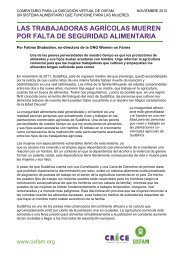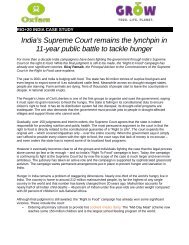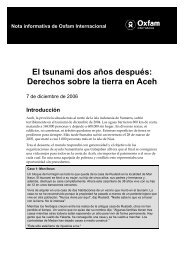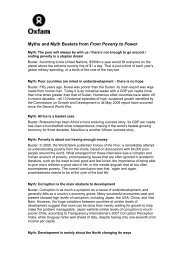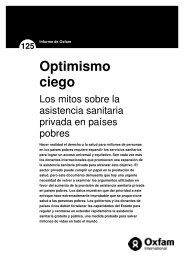Oxfam Strategic Plan, 2013-2019 - Oxfam International
Oxfam Strategic Plan, 2013-2019 - Oxfam International
Oxfam Strategic Plan, 2013-2019 - Oxfam International
You also want an ePaper? Increase the reach of your titles
YUMPU automatically turns print PDFs into web optimized ePapers that Google loves.
THE POWER OF PEOPLE AGAINST POVERTY 27<br />
OXFAM STRATEGIC PLAN, <strong>2013</strong> – <strong>2019</strong><br />
Operational Goal 5:<br />
Cost effectiveness<br />
This <strong>Strategic</strong> <strong>Plan</strong> sets out ambitious goals, some of<br />
which require increased investment against a probable<br />
background of almost zero income growth. Savings<br />
can be achieved both within program activities and by<br />
reconfiguring our ways of working as a confederation in<br />
order to achieve maximum cost effectiveness.<br />
Objectives for <strong>2019</strong><br />
• Economy: the amounts <strong>Oxfam</strong> pays for resources (people,<br />
goods and services) will provide the best possible value<br />
• Efficiency: <strong>Oxfam</strong> will achieve optimum efficiency and<br />
convert the returns into delivery of programs<br />
• Effectiveness: <strong>Oxfam</strong> will secure the best possible<br />
outcomes for its partners and beneficiaries, relative to the<br />
investments it has made<br />
Achieving the goal<br />
Economy<br />
• Align and pool procurement processes – e.g. in<br />
humanitarian response; standardize purchases; focus on<br />
pooling and rationalizing at country level and invest in<br />
technology to increase virtual working to reduce physical<br />
processes (e.g. travel)<br />
expertise for common activities and reach greater sharing<br />
of jobs; reduce the number of affiliates providing common<br />
services and realize economies of scale<br />
• Reduce program management costs as a percentage of<br />
program spend; benchmark affiliate staffing to an agreed<br />
model, and rationalize; define the role of regional hubs;<br />
organize country offices on a team rather than affiliate<br />
basis<br />
• Early in the <strong>Plan</strong> period, introduce ratios and/or targets<br />
for this operational expenditure. We expect these two<br />
complementary objectives of economy and efficiency to<br />
release at least 100m euro over the life of the plan<br />
Effectiveness<br />
• Analyze the impact of different ways of working of <strong>Oxfam</strong><br />
and of partner organizations and prioritize accordingly;<br />
align the configuration of <strong>Oxfam</strong> country programs;<br />
discontinue peripheral programs and reinvest in core<br />
programs and in innovation; realize economies of scale;<br />
rationalize the number of countries where we work<br />
and manage multiple countries on a cluster basis;<br />
encourage affiliates to become “contributors” rather than<br />
“implementers” where appropriate<br />
• Implement a joined-up approach to training, support and<br />
compliance of partner organizations and optimize and<br />
rationalize investments in Fair Trade<br />
The anticipated result of these effectiveness measures is<br />
a rate of return on <strong>Oxfam</strong> investments that increases by at<br />
least 10 % by the end of the <strong>Plan</strong>.<br />
Expected impact by <strong>2019</strong><br />
Throughout the period of the <strong>Strategic</strong> <strong>Plan</strong> <strong>Oxfam</strong> will<br />
be cost-effective in all aspects of its work. Savings<br />
released by cost effectiveness measures will be<br />
reinvested in the achievement of the goals.<br />
Efficiency<br />
• Align ways of working across affiliates and rationalize<br />
structures; after business process analysis and revision,<br />
move to one process for all support services; introduce<br />
one policy and strategy across affiliates, for example, in<br />
communications; invest in knowledge management across<br />
the confederation; reduce transaction costs by applying<br />
the subsidiarity principle for decision-making<br />
• Align and simplify business processes in order to reach<br />
higher levels of standardization in the use of systems<br />
and in the processing of data; develop global centers of



